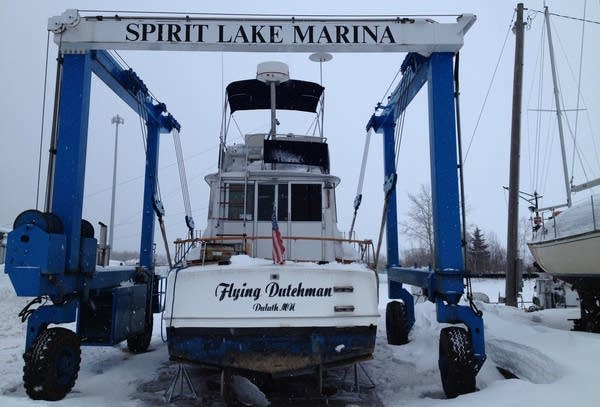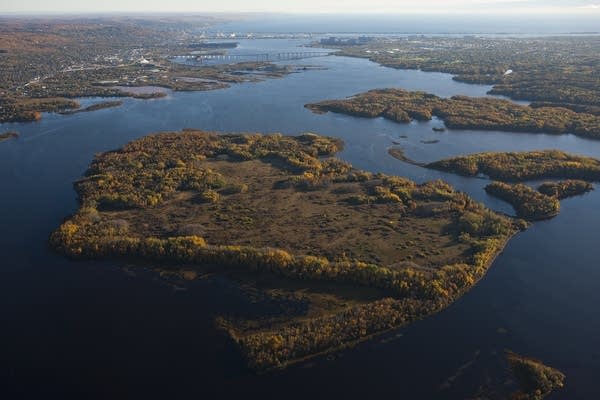Mayor Ness turns Duluth's attention towards St. Louis River communities

Go Deeper.
Create an account or log in to save stories.
Like this?
Thanks for liking this story! We have added it to a list of your favorite stories.
Most people think of Duluth as that city on a lake - Lake Superior, of course. But in his State of the City Address Monday night, Mayor Don Ness laid out a plan to make Duluth equally well known for its location on the St. Louis River. Ness envisions a renaissance on the west side of Duluth that stretches along the river to attract tourists, as well as new residents.
Southwest of downtown Duluth, along the wide expanse of the St. Louis River, is a string of neighborhoods with names like Smithville, Riverside, and Morgan Park. In the early part of the last century they hummed with activity from a nearby US Steel mill and other factories. Now there's an aging population and quiet streets that seem a long way away from bustling Canal Park and downtown Duluth. Ness sees untapped potential there.
"This is about saving these neighborhoods, this is about giving attention to a part of town that has felt neglected for many decades," he said. "Once completed, this vision will bring hundreds of thousands of new visitors to Duluth, hundreds of young families will buy homes in the area, and a new generation of active retirees will find that the St. Louis River communities have everything they're looking for at an affordable price."
Ness wants to invest between $15 million and $18 million in west Duluth by extending a recently expired half-percent food and lodging tax that was used to help transform Canal Park in Duluth from an industrial zone to a major tourist destination. That money would fund more canoe and boat access to the St. Louis River, expand biking and hiking trails, and improve parks and tourist attractions like Spirit Mountain and the Lake Superior Zoo.
Turn Up Your Support
MPR News helps you turn down the noise and build shared understanding. Turn up your support for this public resource and keep trusted journalism accessible to all.
Charlie Stauduhar, who owns Spirit Lake Marina on the St. Louis River, says that investment could attract new residents.
"When you look at some of the growing metro areas around country, those that are most attractive for people to move into are the ones with the hiking trails, the biking trails, and the access to the great outdoors, and we have it all right here in West Duluth," Stauduhar said. "The St Louis River is a hidden gem, when people look at Duluth they look at the lake and don't think of the river."

Another challenge: Many people living in West Duluth are in their 70s and 80s. Ness says the city needs to lure in young families to those neighborhoods.
"If we're not deliberate about creating a new market for the new home buyers, to say, 'I'm excited about the possibility of living along the St Louis River, because of these outdoor recreation opportunities,'" then Ness worries that property values could decline, and more homes may be converted to rental properties.
The mayor's vision is only possible because of the St. Louis River's environmental transformation over the past several decades. Julene Boe, executive director of the St. Louis River Alliance, says the cleanup from decades of industrial pollution started in 1978 with a new wastewater treatment plant.
"Before that, I understand that people didn't want to get near the river because it smelled so bad," she said. "Fish were dying off, plants were dying off, there was not a lot of life in the river because of its low oxygen level."
The estuary was one of the most polluted areas around the Great Lakes in the 1980s. Since then about $420 million dollars have been spent to clean up the river, with an equal amount still to come. The Minnesota Pollution Control Agency has set a goal to have the river removed from its list of areas of concern by 2025.

But challenges remain. The old U.S. Steel site still needs to be reclaimed. Other polluted, former industrial sites sit vacant. Much of the housing stock is around a century old. And the city still copes with what residents have long described as an East-West divide, between the blue collar West and more affluent East. Ness sees this plan as a way to move past that.
"Be proud of both the lakefront and the riverfront: Then we're one Duluth, and we don't have to play the old and tired politics of east vs. west," he said.
Seventy-five year old Will Munger, managing the motel his father opened 55 years ago, echoed that sentiment.
"We've been looking forward in all those 55 years for West Duluth to finally become the center of attention for tourism and I'm glad to see that happening now," he said.
Just behind Munger's small hotel, the Willard Munger Trail, named for his father, who was once a state legislator, ends short of downtown. The city plans to connect the trail to the downtown Lakewalk path.
But for Ness' proposal to come to life, the state legislature and city council need to authorize the city to collect the proposed sales tax. City leaders also are asking for state assistance to improve Spirit Mountain and the area's housing stock.
Still, for Munger, the plan comes a bit too late to help his business. He says he's just finalized a deal to sell the longtime family business.
"I'm going to be able to spend more of my time out on those trails and doing things [in West Duluth] that I tell everyone else to do," he said.


